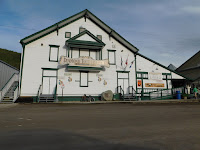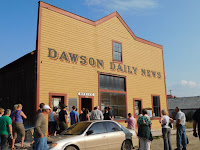As we left
Skagway, AK on July 8 we crossed into Canada.
This was our second of three border crossings. We had forgotten to remove a few items of
produce from our fridge before we left. So when the officer asked us about
produce, we told him what we had. He
just shrugged and let us cross into Canada.
Of course, he asked us about weapons, drugs, etc. but that little bit of
lettuce, bell pepper, and tomato didn’t seem to bother him. Guess we’re getting a little braver, but it’s
still scary because of the horrible stories we’ve heard from others as they’ve
crossed.
We retraced
our route to Whitehorse, YT and stopped in Carmacks, YT for one night after 218
miles of travel. Once we arrived, a
thunderstorm hit the area, but that didn’t stop our Wagon Masters from working
as they normally do – directing all 21 rigs into their assigned sites.
Next
morning, we left for our destination, Dawson City, YT, another 218 miles
away. Road construction signs were very
common on this journey.
 |
| We traveled for miles on dirt roads which were bumpy and dusty. |
A fur
trapper and part-time prospector, Robert Henderson, found gold in Rabbit Creek
(now Bonanza Creek) in 1894, not far from where the Klondike River empties into
the Yukon. (The word “Klondike” is English for the Indian tribe, “Tr’ondek.”) Henderson told his friend, George Carmack,
about his discovery. In 1896, Carmack,
along with two friends who were native companions, discovered gold on Bonanza
Creek in 1896. Carmack registered the
discovery claim and within days, Bonanza and Eldorado Creeks had been staked
from end to end by thousands of prospectors.
Carmack never told Henderson who missed out on the richest claims.
Thirty
thousand pick-and-shovel miners, prospectors, storekeepers, saloon keepers,
bankers, gamblers, prostitutes, and con men from every corner of the continent
poured through snow-choked mountain passes and down the Yukon River to stake
their claim to fortune on creeks with names like Eldorado, Bonanzo, Last
Chance, and Too Much Gold.
 |
| A dredge digs out stream beds and takes the gold from the rocks, then throws the rocks out as waste. |
Most
settlers found no gold at all. But the
prospect of sudden riches was not all that mattered. For many of those who made the incredible
journey, the Klondike represented escape from a boring life and the adventure of
a new frontier. Thus, the town
grew. On the flats of two riverbanks, Dawson
was a city of trampled mud streets, saloons, churches, gambling houses, and
theatrical shows. Beautiful boats, part
of a fleet of 250 paddle-wheelers, ran the Yukon River, bringing in freight,
new frontier settlers, and a new life for many.
The Han people (American Indians) had inhabited the land around the Yukon River for several thousand years and were the natives most affected by the Klondike Gold Rush. They still live in Dawson City where the tribe operates the native cultural center.
Dawson City has chosen to keep the traditional wooden walkways and dirt roads, except for “Front Street,” which is paved. The buildings retain their original structure with at times, a new coat of paint. Below are pictures of downtown Dawson City:
The Han people (American Indians) had inhabited the land around the Yukon River for several thousand years and were the natives most affected by the Klondike Gold Rush. They still live in Dawson City where the tribe operates the native cultural center.
Dawson City has chosen to keep the traditional wooden walkways and dirt roads, except for “Front Street,” which is paved. The buildings retain their original structure with at times, a new coat of paint. Below are pictures of downtown Dawson City:
 |
| Front Street businesses |
 |
| Beautiful flower beds in Dawson City |
 |
| Hotel, Restaurant, and Lounge |
 |
| Houses in Dawson City |
 |
| Diamond Tooth Gerties Casion, Saloon, and Theater |
As the Northern Exposure Caravan was being planned, we learned that a few SMART members chose not to drive across “The Top of the World Highway.” This road is known for its rough washboard dirt roads, steep inclines, and 11% grades with no side rails, etc. Four SMART members chose to retrace the route -700 miles - to avoid this terrifying road. Well, look for the next blog to find out what happens as our caravan leaves Dawson City, YT.




No comments:
Post a Comment